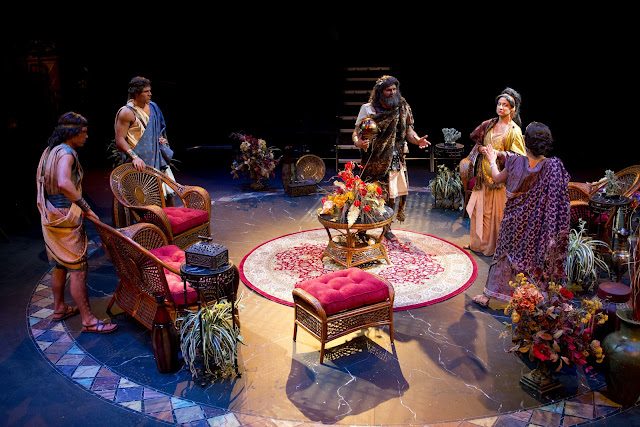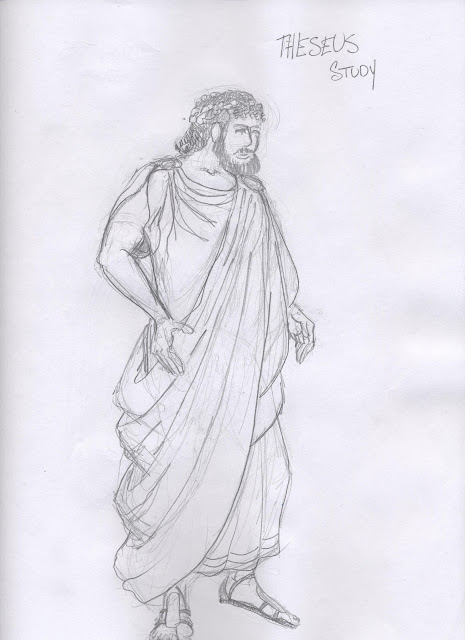 |
| Phèdre cast |
Synopsis
Theseus, the king of Athens is missing and presumed dead. His son, Hippolytus has been living in Troezen as a "jailer" to the Princess Aricia who is the last remaining heir of the royal house Theseus defeated to come to power. Theseus will not allow her to marry because he believes she will bear a child with a claim on the throne, but he also does not wish to kill her.
Hippolytus confides to his manservant and best friend, Theramenes that he is in love with Aricia and wants to leave because it is in direct conflict with his father's order. With his father's apparent death, though Hippolytus becomes king of Troezen and resolves to free Aricia of the barbaric law his father set.
Phèdre, enters with her bodyservant, Oenone. She is very ill and reveals she has been slowly poisoning herself because of some sin she has committed. Through the scene we learn the sin she is guilty of is being in love with her stepson, Hippolytus. Oenone convinces her that now Theseus is dead, her love of his son is no longer wrong and she should confess to him.
Hippolytus confesses his love to Aricia when he frees her and tells her he will not seek to press his claim to the throne of Athens but instead would support her claim over Phèdre's son's. Aricia has been secretly in love with Hippolytus for some time and tells her friend and confidant Ismene. All seems to be well.
As he tries to take leave of Phèdre, she confesses her love for him and he leaves, horrified. In the process he leaves his sword behing. At that moment, Panope, the messenger enters and says that the dead king is not dead and has returned and will be at the palace in a short time. Phèdre, not wishing to face her shame gives Oenone permission to tell the king whatever she will.
 |
| Theseus helm |
He confronts Hippolytus, who denies any wrongdoing except that he is in love with Aricia against his father's wishes. Theseus thinks that is a ploy to divert his guilt and calls down a curse against him from Neptune, who incidentally owes him a favor. Hippolytus leaves.
Phèdre, upon hearing of the curse, confronts Oenone and learns what she has done and casts her out. Oenone does what any self respecting servant would do in this situation and casts herself off a cliff into the sea.
Hippolytus and Aricia arrange to meet at a shrine later and marry in secret. They say their goodbyes, and he leaves, resolved to honor his father with his deeds. Theseus enters and Aricia tells him that she and Hippolytus really do love one another and he was wrong. Theseus doesn't believe her right away but she has sown the seed of doubt. He decides to get to the bottom of things and calls for Oenone. Panope shows up instead and tells him of Oenone's death.
Meanwhile, Theramenes shows up and tells the king in a three page monologue how Neptune struck down his son at his request. Theramenes is slightly disrespectful to the king and the king takes it, does nothing. Theramenes tells him his son's last request was for him to restore all things to Aricia.
Finally Phèdre shows up, sick from poison administered by her own hand, confesses everything and dies. Theseus mourns very loudly and decrees, in accordance with his son's dying wish that all things are restored to Aricia and he adopts her.
Concept
When the director, Hyrum Conrad and I discussed the concept of this play, he said he would really like to do the play in a straightforward way, in Greek dress. He wanted the world of the play to be more colorful than stereotypical Greek dress. He was very interested in deep jewel tones. I suggested we should look to the French neo-classical painters and their conception of Greek dress, since this was a French neo-classic play.
We had just done Oedipus the summer before and Hyrum suggested that he'd like to use costumes from that production to clothe the lesser characters which meant we would build all of Phèdre's costumes, all of Theseus', all of Hippolytus and all of Aricia's costumes. The rest I would use stock and accessorize differently than they had been used before.
Research
The basic garment worn by the Greeks was called a Chiton which is essentially a rectangular piece of linen wrapped around the body once and fastened with Fibulae (ancient Greek version of a safety pin) over the shoulders and sometimes down the side. Often the chiton was held in place by a cord or a belt tied at the waist or under the bust.
The chiton was covered in public with a garment called a Himation which was a long rectangular piece of linen that was wrapped in a multitude of ways around the body. The status of a person was often shown by the size and wrapping of the himation, the greater the status, the more elaborate the garment.
Greeks used to wear a garment called a Chlamys for travel. A chlamys is a smaller rectangle or square of fabric draped either over or under one arm and fastened over the other shoulder with a fibulae. A chlamys is kind of like a cape in modern parlance.
When I first began working on this design I remembered several images of the Emperor Napoleon by Andrea Appiani, dressed in Greek or Roman garb and I used these as my starting place. From there I began researching French Neoclassicist painters, especially the images of what they imagined Greek life to be. Jacques-Louis David painted many Greek scenes and I found his work very helpful in creating my aesthetic for this show. I did not limit my research to his work, however.
Among the images I was inspired by were:
- Anger of Achilles by Jacques-Louis David, 1825
- Gold painting on red and blue chlamys'
- The Farewell of Telemachus and Eucharis by Jacques-Louis David, 1818
- Headband with fringe
- Gold painting or embroidery on edge of chlamys
- Fibulae down side of her chiton
- jewels stitched to her chiton
- Hairstyles
- Mars Being Disarmed by Venus and the Three Graces by Jacques-Louis David, 1824.
- Tassel on headband
- Gold trim on himation
- Sandals with top panel
- Paris and Helen by Jacques-Louis David, 1788
- Headband
- Tassels on himation
- Trim on edges of fabric
- Hairstyles
- Oedipus at Colonus by Jean-Antoine Theodore Giroust, 1788
- Himation draped over woman's head
- Gold trim on edge of Chiton
- Sandals
- Chlamys
- Headbands
- Allegorie Relative by Jean-Jacques Lagrenée, 1783
- Headbands
- Hairstyles
- Small Chlamys
- Romulus' Victory over Acron by Jean-Auguste-Dominique Ingres, 1812
- Gold laurel wreath crown
- Red himation with gold trim
- Large chiton
- Armor
For some reason, I chose to work on Theseus first. He seemed to be the character that I had the first strong impressions about. He seemed strong but misguided. A man prone to make snap decisions which usually works for him but in this case he errs. I viewed him as larger than life and yet sympathetic. This is a man who pals around with the gods. I saw him as a man trying to emulate Heracles and Zeus. His first entrance has Theseus returning from a 6 month adventure in which everyone thought he had perished. I wanted to give him an almost feral look so I did a rough sketch of him with a large cat skin as a himation and showed it to Hyrum. I didn't think he'd go for it but he did.
 |
| Quick sketch of Theseus first look |
 |
| Theseus first look |
 |
| Quck sketch of Theseus second look |
 |
| Theseus "Zeus" look |
 |
| Theseus last look |
 |
| Theseus sketch, adapted and merged with another drawing for Hippolytus |
 |
| Hippolytus for Act V |
 |
| Hippolytus and Aricia, Act V |
 |
| Hippolytus and Theramenes, Act I |
 |
| Phèdre and Oenone, Act I |
 |
| Aricia and Ismene, Act II |
 |
| Oenone, Phèdre and Hippolytus, Act II |
 |
| Oenone and Phèdre, Act III. Phèdre's courtly himation |
 |
| Panope and Theseus, Act V |
The lighting design for this play was fairly straightforward. I divided the stage into five areas and four fill areas. Each area was lit from eight directions with ETC source 4's. For color shifts I used a combination of Seachangers and color scrollers. I also used foliage gobos for the exterior scenes and window gobos for the interiors. Nothing really innovative in the regular light hang.
I took a chance on the downlight, however with very satisfactory results. We hung three ETC PARNel's above each area, each focused to the exact same spot, one gelled red, one green and one blue. This allowed me to color mix on the stage rather than using color scrollers. Scrollers are noisy and if your colors aren't adjacent on the scroll you have to run through colors to get to the one you really want. That makes them unwieldy when trying to change color rapidly within a scene.
From the three colors I was able to create white light, amber, cyan, magenta and various shades inbetween just like lighting color theory suggests. It was a neat effect and I intend to incorporate it into future designs when appropriate. The effect is visible to a degree in some of the photos above.
I enjoyed the design process and its results in this production. We paid special attention to character development through costume, which I felt was successful. I also enjoyed the grand experiment with down lighting. I will use it again.
Production Details
Directed by Hyrum Conrad
Scene Design by Hyrum Conrad
Costume Design by Gary Benson
Lighting Design by Gary Benson
Technical Director: Ray Versluys
Costume Shop Director: Patty Randall
No comments:
Post a Comment